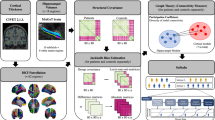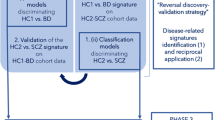Abstract
Neurocognitive deficits are frequently observed in patients with schizophrenia and major depressive disorder (MDD). The relations between cognitive features may be represented by neurocognitive graphs based on cognitive features, modeled as Gaussian Markov random fields. However, it is unclear whether it is possible to differentiate between phenotypic patterns associated with the differential diagnosis of schizophrenia and depression using this neurocognitive graph approach. In this study, we enrolled 215 first-episode patients with schizophrenia (FES), 125 with MDD, and 237 demographically-matched healthy controls (HCs). The cognitive performance of all participants was evaluated using a battery of neurocognitive tests. The graphical LASSO model was trained with a one-vs-one scenario to learn the conditional independent structure of neurocognitive features of each group. Participants in the holdout dataset were classified into different groups with the highest likelihood. A partial correlation matrix was transformed from the graphical model to further explore the neurocognitive graph for each group. The classification approach identified the diagnostic class for individuals with an average accuracy of 73.41% for FES vs HC, 67.07% for MDD vs HC, and 59.48% for FES vs MDD. Both of the neurocognitive graphs for FES and MDD had more connections and higher node centrality than those for HC. The neurocognitive graph for FES was less sparse and had more connections than that for MDD. Thus, neurocognitive graphs based on cognitive features are promising for describing endophenotypes that may discriminate schizophrenia from depression.





Similar content being viewed by others
References
Buckley PF, Miller BJ, Lehrer DS, Castle DJ. Psychiatric comorbidities and schizophrenia. Schizophr Bull 2009, 35: 383–402.
Bentall RP, Rowse G, Shryane N, Kinderman P, Howard R, Blackwood N, et al. The cognitive and affective structure of paranoid delusions: a transdiagnostic investigation of patients with schizophrenia spectrum disorders and depression. Arch Gen Psychiatry 2009, 66: 236–247.
Insel T, Cuthbert B, Garvey M, Heinssen R, Pine DS, Quinn K, et al. Research domain criteria (RDoC): toward a new classification framework for research on mental disorders. Am J Psychiatry 2010, 167: 748–751.
Siris SG. Depression in schizophrenia: perspective in the era of “Atypical” antipsychotic agents. Am J Psychiatry 2000, 157: 1379–1389.
Bressler SL, Menon V. Large-scale brain networks in cognition: emerging methods and principles. Trends Cogn Sci 2010, 14: 277–290.
Rubinov M, Bullmore E. Schizophrenia and abnormal brain network hubs. Dialogues Clin Neurosci 2013, 15: 339–349.
Hamilton JP, Chen G, Thomason ME, Schwartz ME, Gotlib IH. Investigating neural primacy in Major Depressive Disorder: multivariate Granger causality analysis of resting-state fMRI time-series data. Mol Psychiatry 2011, 16: 763–772.
Gong Y. Wechsler adult intelligence scale-revised in China Version. Hunan Medical College, Changsha, Hunan/China 1992.
Gong Y. Wechsler Memory Scale–Revised in China. Hunan Medical College, Changsha, Hunan/China 1989.
Levaux MN, Potvin S, Sepehry AA, Sablier J, Mendrek A, Stip E. Computerized assessment of cognition in schizophrenia: promises and pitfalls of CANTAB. Eur Psychiatry 2007, 22: 104–115.
Johnston BA, Coghill D, Matthews K, Steele JD. Predicting methylphenidate response in attention deficit hyperactivity disorder: a preliminary study. J Psychopharmacol 2015, 29: 24–30.
Sahakian B, Owen A. Computerized assessment in neuropsychiatry using CANTAB: discussion paper. J R Soc Med 1992, 85: 399.
Robbins TW, James M, Owen AM, Sahakian BJ, Lawrence AD, McInnes L, et al. A study of performance on tests from the CANTAB battery sensitive to frontal lobe dysfunction in a large sample of normal volunteers: implications for theories of executive functioning and cognitive aging. Cambridge Neuropsychological Test Automated Battery. J Int Neuropsychol Soc 1998, 4: 474–490.
Wu MJ, Passos IC, Bauer IE, Lavagnino L, Cao B, Zunta-Soares GB, et al. Individualized identification of euthymic bipolar disorder using the Cambridge Neuropsychological Test Automated Battery (CANTAB) and machine learning. J Affect Disord 2016, 192: 219–225.
Haring L, Muursepp A, Mottus R, Ilves P, Koch K, Uppin K, et al. Cortical thickness and surface area correlates with cognitive dysfunction among first-episode psychosis patients. Psychol Med 2016, 46: 2145–2155.
Lu L, Bigler ED. Performance on original and a Chinese version of Trail Making Test Part B: a normative bilingual sample. Appl Neuropsychol 2000, 7: 243–246.
Koller D, Friedman N. Probabilistic Graphical Models: Principles and Techniques-Adaptive Computation and Machine Learning. The MIT Press, 2009.
Friedman J, Hastie T, Tibshirani R. Sparse inverse covariance estimation with the graphical lasso. Biostatistics 2008, 9: 432–441.
Yang Y, Dong Y, Chawla NV. Predicting node degree centrality with the node prominence profile. Sci Rep 2014, 4: 7236.
Opsahl T, Agneessens F, Skvoretz J. Node centrality in weighted networks: Generalizing degree and shortest paths. Soc Networks 2010, 32: 245–251.
Benzi M, Klymko C. A matrix analysis of different centrality measures. arXiv preprint arXiv:1312.6722 2014.
Terachi S, Yamada T, Pu S, Yokoyama K, Matsumura H, Kaneko K. Comparison of neurocognitive function in major depressive disorder, bipolar disorder, and schizophrenia in later life: A cross-sectional study of euthymic or remitted, non-demented patients using the Japanese version of the Brief Assessment of Cognition in Schizophrenia (BACS-J). Psychiatry Res 2017, 254: 205–210.
Reichenberg A, Harvey PD, Bowie CR, Mojtabai R, Rabinowitz J, Heaton RK, et al. Neuropsychological function and dysfunction in schizophrenia and psychotic affective disorders. Schizophr Bull 2009, 35: 1022–1029.
Jeste DV, Heaton SC, Paulsen JS, Ercoli L, Harris J, Heaton RK. Clinical and neuropsychological comparison of psychotic depression with nonpsychotic depression and schizophrenia. Am J Psychiatry 1996, 153: 490–496.
Barch DM, Sheline YI, Csernansky JG, Snyder AZ. Working memory and prefrontal cortex dysfunction: specificity to schizophrenia compared with major depression. Biol Psychiatry 2003, 53: 376–384.
Walter H, Vasic N, Hose A, Spitzer M, Wolf RC. Working memory dysfunction in schizophrenia compared to healthy controls and patients with depression: evidence from event-related fMRI. Neuroimage 2007, 35: 1551–1561.
Stern Y. The concept of cognitive reserve: a catalyst for research. J Clin Exp Neuropsychol 2003, 25: 589–593.
Liu Y, Liang M, Zhou Y, He Y, Hao Y, Song M, et al. Disrupted small-world networks in schizophrenia. Brain 2008, 131: 945–961.
Whitfield-Gabrieli S, Thermenos HW, Milanovic S, Tsuang MT, Faraone SV, McCarley RW, et al. Hyperactivity and hyperconnectivity of the default network in schizophrenia and in first-degree relatives of persons with schizophrenia. Proc Natl Acad Sci U S A 2009, 106: 1279–1284.
Hu ML, Zong XF, Mann JJ, Zheng JJ, Liao YH, Li ZC, et al. A review of the functional and anatomical default mode network in schizophrenia. Neurosci Bull 2017, 33: 73–84.
McIntyre RS, Cha DS, Soczynska JK, Woldeyohannes HO, Gallaugher LA, Kudlow P, et al. Cognitive deficits and functional outcomes in major depressive disorder: determinants, substrates, and treatment interventions. Depress Anxiety 2013, 30: 515–527.
Snyder HR. Major depressive disorder is associated with broad impairments on neuropsychological measures of executive function: a meta-analysis and review. Psychol Bull 2013, 139: 81–132.
White DA, Myerson J, Hale S. How cognitive is psychomotor slowing in depression? Evidence from a meta-analysis. Aging Neuropsychol Cogn 1997, 4: 166–174.
Albus M, Hubmann W, Wahlheim C, Sobizack N, Franz U, Mohr F. Contrasts in neuropsychological test profile between patients with first-episode schizophrenia and first-episode affective disorders. Acta Psychiatr Scand 1996, 94: 87–93.
Kaiser RH, Andrews-Hanna JR, Wager TD, Pizzagalli DA. Large–scale network dysfunction in major depressive disorder: A meta-analysis of resting-state functional connectivity. JAMA Psychiatry 2015, 72: 603–611.
Zhu X, Wang X, Xiao J, Liao J, Zhong M, Wang W, et al. Evidence of a dissociation pattern in resting-state default mode network connectivity in first-episode, treatment-naive major depression patients. Biol Psychiatry 2012, 71: 611–617.
Zhang K, Zhu Y, Wu S, Liu H, Zhang W, Xu C, et al. Molecular, functional, and structural imaging of major depressive disorder. Neurosci Bull 2016, 32: 273–285.
Busatto GF. Structural and functional neuroimaging studies in major depressive disorder with psychotic features: a critical review. Schizophr Bull 2013, 39: 776–786.
Egeland J, Sundet K, Rund BR, Asbjornsen A, Hugdahl K, Landro NI, et al. Sensitivity and specificity of memory dysfunction in schizophrenia: a comparison with major depression. J Clin Exp Neuropsychol 2003, 25: 79–93.
Egeland J, Rund BR, Sundet K, Landro NI, Asbjornsen A, Lund A, et al. Attention profile in schizophrenia compared with depression: differential effects of processing speed, selective attention and vigilance. Acta Psychiatr Scand 2003, 108: 276–284.
Bernstein HG, Ortmann A, Dobrowolny H, Steiner J, Brisch R, Gos T, et al. Bilaterally reduced claustral volumes in schizophrenia and major depressive disorder: a morphometric postmortem study. Eur Arch Psychiatry Clin Neurosci 2016, 266: 25–33.
Haybaeck J, Postruznik M, Miller CL, Dulay JR, Llenos IC, Weis S. Increased expression of retinoic acid-induced gene 1 in the dorsolateral prefrontal cortex in schizophrenia, bipolar disorder, and major depression. Neuropsychiatr Dis Treat 2015, 11: 279–289.
Green EK, Grozeva D, Jones I, Jones L, Kirov G, Caesar S, et al. The bipolar disorder risk allele at CACNA1C also confers risk of recurrent major depression and of schizophrenia. Mol Psychiatry 2010, 15: 1016–1022.
Fillman SG, Cloonan N, Catts VS, Miller LC, Wong J, McCrossin T, et al. Increased inflammatory markers identified in the dorsolateral prefrontal cortex of individuals with schizophrenia. Mol Psychiatry 2013, 18: 206–214.
Bufalino C, Hepgul N, Aguglia E, Pariante CM. The role of immune genes in the association between depression and inflammation: a review of recent clinical studies. Brain Behav Immun 2013, 31: 31–47.
Acknowledgements
We gratefully acknowledge the participants in this study for their generous participation. This work was partially funded by National Nature Science Foundation of China Key Projects (81130024, 91332205, and 81630030), the National Key Technology R & D Program of the Ministry of Science and Technology of China (2016YFC0904300), the National Natural Science Foundation of China/Research Grants Council of Hong Kong Joint Research Scheme (8141101084), the Natural Science Foundation of China (8157051859), the Sichuan Science & Technology Department (2015JY0173), the Canadian Institutes of Health Research, Alberta Innovates: Centre for Machine Learning, and the Canadian Depression Research & Intervention Network.
Author information
Authors and Affiliations
Corresponding author
Electronic supplementary material
Below is the link to the electronic supplementary material.
Rights and permissions
About this article
Cite this article
Liang, S., Vega, R., Kong, X. et al. Neurocognitive Graphs of First-Episode Schizophrenia and Major Depression Based on Cognitive Features. Neurosci. Bull. 34, 312–320 (2018). https://doi.org/10.1007/s12264-017-0190-6
Received:
Accepted:
Published:
Issue Date:
DOI: https://doi.org/10.1007/s12264-017-0190-6




